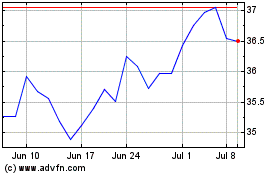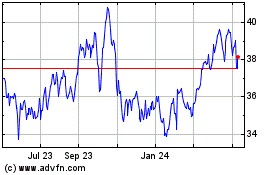BP Results Still Hurt by Gulf of Mexico Spill -- 2nd Update
April 26 2016 - 7:14AM
Dow Jones News
By Sarah Kent
LONDON-- BP PLC's fatal blowout in the Gulf of Mexico in 2010
continues to haunt the company, helping to drag its quarterly
earnings into a second consecutive loss and overshadowing progress
on cost cuts that caused the firm's shares to jump over 4%.
BP on Tuesday said its earnings took a $917 million hit in the
first quarter related to the Deepwater Horizon explosion that
killed 11 workers and caused a massive spill in the Gulf of Mexico,
a disaster that changed the course of the British oil giant and
cost the company $56.4 billion to date.
The additional spill costs and the weakest oil prices in over a
decade cast a cloud over BP's financial performance, despite signs
that heartened investors.
Counting the Deepwater Horizon costs, BP said its equivalent of
net earnings was a $485 million quarterly loss. Stripping out those
and other one-time charges, BP had a profit of $532 million in the
first quarter, significantly beating analysts' consensus forecast
for a loss of $140 million.
The spill forced the company to sell more than $40 billion in
assets, pull back its ambitions and craft the business around a
smaller set of high-value oil and gas fields.
A roughly $20 billion settlement with the U.S. government--given
final approval by a judge this month--resolved nearly all legal
claims arising from the accident. But the company still faces
additional civil litigation and ongoing costs related to the
disaster, including an annual liability of around $1 billion
imposed by the settlement that stretches out over roughly two
decades.
The most recent spill-related costs included $600 million
related to business and economic loss claims the company hadn't
previously provided for, as well as settlement costs for certain
civil claims outside of a 2012 agreement on economic, property or
medical damage claims.
BP said the charge reflected its efforts to accelerate
procedures for processing such claims, but that it still can't
"reliably estimate the remaining liability for these claims."
The ongoing fallout from the massive oil spill is weighing on
the company during an exceptionally difficult period for the energy
sector. A glut in global crude supply has led to a nearly two-year
slump in prices, dragging down earnings across the industry and
forcing painful spending cuts.
Oil prices hit a 13-year low during the first quarter, and Brent
crude, the international benchmark, averaged $34 a barrel, compared
with $54 a barrel in the same period a year earlier.
The slumping market has forced BP to make spending cuts that,
though painful, helped the company make a profit when its earnings
are adjusted to strip out one-time charges like spill costs.
BP said it now expects its capital expenditure to total around
$17 billion this year, down from a peak of $25 billion in 2013. By
next year it expects its cash costs to be $7 billion lower than for
2014, allowing the company to balance its spending and cash flow at
oil prices of $50 to $55 a barrel. Over the past 12 months, costs
are already down $4.6 billion compared to 2014.
"This progress underpins our commitment to sustaining BP's
dividend as the first priority within our financial frame," Chief
Financial Officer Brian Gilvary said in a news release. "Should
prices remain low, we have the flexibility to adjust further within
the financial framework."
The company has already announced plans to cut 7,000 jobs this
year and in its first quarter results flagged the possibility that
it could lower spending still further to $15 billion to $17 billion
in 2017 if prices remain under pressure.
The company's dividend remains unchanged at 10 cents per
ordinary share, although at its annual meeting in London earlier
this month BP's chairman Carl-Henric Svanberg warned that
adjustments to the company's shareholder payouts could be necessary
if energy prices remain under pressure for longer than
expected.
As in previous quarters, BP's refining and marketing arm helped
cushion the impact of weak prices on its exploration and production
business, despite profit margins for refineries that were at their
lowest quarterly average in over five years. Lower costs, strong
refining operations and good results from the company's trading
business helped boost the division's pretax profit to $1.9 billion
from $838 million in the fourth quarter of 2015.
BP's "progress on cost reductions is apparent in the results,"
said Jason Gammel, a European oil analyst with the investment bank
Jefferies, though he said in a note that the company's cash flow
was lower than expected.
Write to Sarah Kent at sarah.kent@wsj.com
(END) Dow Jones Newswires
April 26, 2016 06:59 ET (10:59 GMT)
Copyright (c) 2016 Dow Jones & Company, Inc.
BP (NYSE:BP)
Historical Stock Chart
From Mar 2024 to Apr 2024

BP (NYSE:BP)
Historical Stock Chart
From Apr 2023 to Apr 2024
